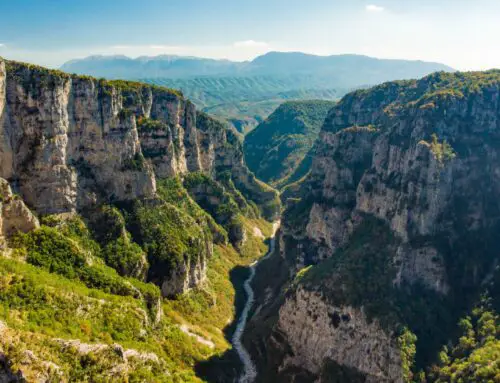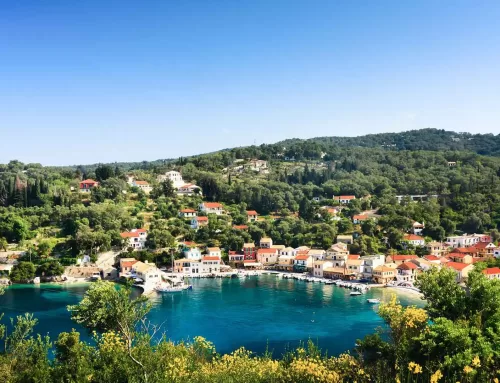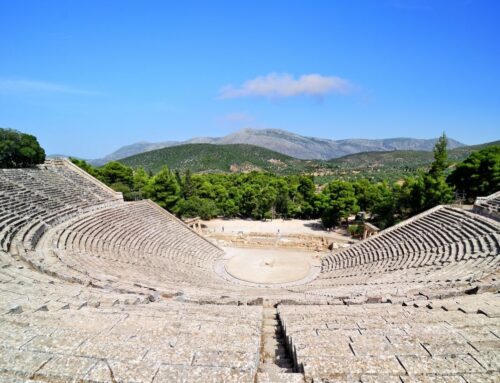
What Is It Like Climbing The Tallest Mountain In Greece?
What Is It Like Climbing The Tallest Mountain In Greece?



☞ Table of Contents:
For us, people growing up in Greece, there have always been a few things that we are fascinated by.
The islands, the mountains, the battlefields. History, mythology and nature.
How can we not? We know that they are as old as time. We live and breathe our homeland. We have been inspired for centuries now by its magnificence. The bright sun has always been giving life. The sea has become the path for adventure. The mountains offer a birds-eye view that has opened the mind and soul to seek the new, to go further.
Psychology and sociology both accept that our environment provides the means for human development. History and archaeology prove it. People who live in mountainous lands have always been restless explorers. And those that live by the sea become the pioneers of international trade.
The glorious masses of mountains have also inspired traditional storytelling, folksongs and mythology.
A great example in Greece is Olympus Mountain.
Massive indeed it is the tallest mountain in Greek territory. It’s in the border between Thessaly and Macedonia, southwest of Thessaloniki.
With a circumference of 150km and an average diameter of 26km it occupies almost 600km2. With 52 peaks, screes, deep gorges characterized by lush vegetation, chasms, caves, springs and ravines it is a marvel to explore! Mytikas (meaning “nose”) is the highest peak. It rises to 2.918m (9.573ft).
To the northwest lies the village of Kokkinoplos and to the northeast Dion. The villages Karya and Sykaminea are on the southwestern foothills. On the southeastern ones lies Litochoron which is very close to the sea.
Up and Up We Go
From there we can start the most interesting walk on Enipeas’ gorge’s paths. To really understand the beauty of the mountain you have to be open, relaxed and ready for an adventure.
A sharp-eyed traveller immediately notices the history around them. Two hundred million years ago there was a shallow sea at the area. Mount Olympus was formed by sediments and various geological events caused that caused the emergence of the mountain. Glaciers formed 1 million years ago, covered Olympus and created plateaus and chasms that led to creeks and gorges. Air, water and snow with their corrosive strength led to soil erosion reminding us that a mountain is actually a living and eternally developing entity and that nature’s inevitable ways cannot be stopped.
You are in “Portes” (doors) now. You realize all you have read is true. Vertical, steep slopes of rock surround you. It is the act of a violent geological incident indeed. The overwhelming sentiment by your contact with nature wins. You hear the water flowing. You keep walking on the path next to it traversing river Enipeas through several wooden bridges and steps formed in the soft soil. Sometimes you walk next to waterfalls. There are often pools of green-blue water. Little creatures, amphibians, turtles, lizards and insects interrupt your steps and keep you company.
Lost in Nature
As you walk further the altitude increases. The lush vegetation will draw your attention. It is characterized by evergreen broad leaves and sort bushes. Mount Olympus is rich in flora and fauna. It is considered one of the richest flora regions in Greece with about 1.700 species that represent 25% of the Greek flora. Wild boars and foxes can be seen. Squirrels and weasels too.
After the cave with the little church of St Dionysius and as you walk towards “Prionia”, the ecosystem of the European black pine forms compact clusters. In this zone it’s humid and beech makes its appearance. Sometimes the tree canopy is so dense that little light gets through. “Prionia” (Saws), as the name itself shows, was the place where lumberjacks used to saw timber and move it via the river. Today there is a refuge for the tired travellers and no sawing takes place any more but scattered logs left in the pools of river Enipeas can still be seen, a reminder of the past.
You are now energized and well connected to the mountain. This spot is considered to be the heart of it!
We Are Struggling But Not Stopping
From this point, the paths become hillier, more vertical, and large rocks seem to interrupt them. The use of supporting logs is inevitable in order to hold the soil. Roots interrupt your steps. You need to be careful as you walk up what now feels like a gigantic staircase. Again you notice steep, vertical slopes and huge rocks around you. The mountain peaks seem closer now.
You can’t help thinking about history and how those paths have been used through centuries. First were the Ancient Greeks, who believed in the Twelve Gods of Olympus and used them to ascend to St Antonius peak, the furthermost point they could reach. That is where the sanctuary of Zeus was, as the archaeological findings prove, and where sacrifices were once made.
Much later, during the Ottoman occupation, the trails were used by Kleftes and Armatoloi. At the beginning of the 20th-century robbers were active in the region. During the German invasion, the Greek army fought battles along with units of New Zealanders and Australians. The mountain was one of the centres of the Greek Resistance and later the Greek Civil War started here in Litochoro. You may be thinking of the mythology that surrounds this place too. Maybe it’s because you are so close to Zeus’ throne. You almost see it!
The Myths and Legends
The Twelve Gods of Olympus were believed to live in the peaks by ancient Greeks. They ate ambrosia and drank nectar. They were also called Olympians, named after their residence. Six Gods and six Goddesses formed the Greek Pantheon.
- Zeus (King of Gods and ruler of humans. God of the sky, thunder, law, order and justice)
- Poseidon (God of the seas, waters, storms and earthquakes)
- Apollo (God of music, light, sun, prophesy, art, medicine)
- Hermes (God of travel, commerce, communication. Messenger of the Gods)
- Ares (Bloodthirsty God of war and violence)
- Hephaestus (Master blacksmith and craftsman of the Gods but ugly and handicapped)
- Hera (Queen of the Gods and Goddess of marriage and family)
- Athena (Goddess of wisdom, intelligence and strategic warfare)
- Artemis (Goddess of hunting, of the wilderness, of virginity and archery)
- Aphrodite (Goddess of beauty, desire, love and fertility)
- Demeter (Goddess of harvest, agriculture, fertility and seasons)
- Hestia (Goddess of housekeeping and family).
They managed to be rulers after a ten years war against the Titans. Cronus and Rhea (Titans) were their parents. Cronus was anxious not to lose his throne and after each birth insisted that Rhea presented him with the child.
Then each and every time he devoured his offspring making sure that his throne was secure. Zeus who was the last in line to be born was lucky enough to be saved. Rhea gave birth to Zeus in Crete. She kept him hidden in a cave and he was raised by a goat named Amalthea. Instead of the baby, she offered Cronus a stone wrapped in cloths. Cronus promptly swallowed it believing it was his son. When Zeus grew up he released his brothers and sisters by giving Cronus an emetic.
A great war followed (Titanomachia) where Zeus and his brothers and sisters won and became Gods of the humans. Homer narrates that Gods were looking after humans and emerged covered in fog, unrecognizable to men and offered the humans solutions, reason, orders or punishment and thus results. How wise of ancient Greeks to give each God something to represent as life dictated!
All the important things like love, family, craftsmanship, communication, art, wisdom, nature, even the unpleasant ones like war and ugliness were attributed to the Gods of Olympus. That is what real life is about! We can’t omit either of them.
Almost at the Top
As you are moving on you are tired but also more excited! You are reaching the top! For quite some time now you have been feeling the mountain’s energy and admiring the beautiful scenery. If you are lucky wild goats can be seen from afar. Another refuge is close, famous for the views it provides especially during sunrise and sunset. Here the Pinus heldreichii tree or Rompolo dominates. Vegetation becomes thin and often crawling. The treks are rockier. Steep dangerous screes and then mountain pastures alternate with peaks and scores and rocky paths. Gaps and notches. Alpine tundra starts. It is extensive with no trees. And yet here live most of the endemic rare plants of Olympus. Twenty-three of them in total.
All this time you have been ascending just to admire the geological miracle called “The Throne of Zeus” or “Stefani” (meaning “ring, crown”, 2.912m altitude). And now it is in front of you! A curvy scalloped vertical slope where there is snow even during summer time! Its base is consecutive zones of rock, the “Zonaria” area (means belts), as people call them.
Just let your eyes rest following the descending slope all the way until the very bottom. Magnificent scenery indeed! On the left and behind the Throne is Mytikas, Greece’s highest peak. Trekkers ascend almost climbing and with caution to admire birds-eye views as far as the clouds and the weather allows!
Should you choose to walk to the other side of the “Throne of Zeus” there is another refuge for the travellers to rest and absorb all this beauty!
Right after that is an alpine pasture, the “Plateau of the Muses”.
The Muses were inspirational goddesses of art and science and were also living with the Gods in Mount Olympus. According to Hesiod, they were born in Pieria by Zeus and Mnemosyne. They used to entertain the Gods and especially Zeus. That is why the plateau near Mytikas peak is named after them.
The so-called “neck” right after the “Plateau of the Muses” is marvelous. A raised strip of land with vertical slopes on each side that provides stunning views of the sea and of the heart of the mountain depending on which side one looks at.
For all these reasons the many winding paths of Olympus are often packed with hikers, ascending or descending, staring in wonder at the beauty of their surroundings, overwhelmed with awe by the magnificent scenery, the breathtaking views, the sunrises and sunsets. Visitors are always welcome at the refuges and minor emergency shelters. Olympus become the first National Park of Greece in 1938 and has been included by UNESCO in the list of Natural Heritage Sites.
There are also trail races being carried out on the paths of Olympus justifying the great love people have for the mountain! Olympus Marathon specifically has been included on the calendar of Skyrunner World Series© since 2017!
We Will Be Back
As we are coming back from the mountain, we have already realized that each of us trekkers, nature lovers, athletes, visitors, have somehow become a little wiser today. Considering all that is needed to absorb, protect and admire this place, we, just like the Muses have become the source of knowledge that will make sure to protect this land in the future.
What a relief from everyday madness and what a blessing indeed to have places like these we can visit.
*Disclaimer: This page might include affiliate links. If you decide to book something through one of them, I might get a little bonus, but it won't cost you anything extra.*

























